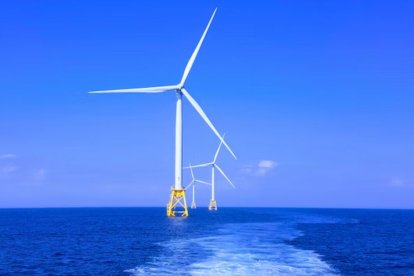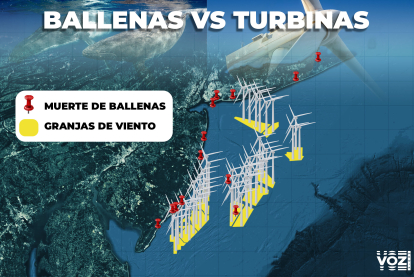The dark side of wind energy
Several studies warn that wind farms increase the earth's temperature and now experts are investigating whether turbines located near the coast are responsible for the increase in beached whales.

(Unsplash)
Green energy continues to reveal its dark side. More and more studies are showing the negative effects that current renewable technologies are having on the planet. Following reports showing that wind farms increase the earth's temperature, several experts have stated that the installation of windmills at sea is causing a dramatic increase in whale and dolphin deaths off the U.S. coast.

mapa-ballena
Since December 1 of last year, the National Oceanic and Atmospheric Administration (NOAA) has reported the deaths of 33 large whales on East Coast beaches between Florida and Maine. Although NOAA considers that there is "no scientific evidence" of a direct link, the number of beached whales skyrocketed since 2016, precisely the date when the first offshore wind farms began operating. So far this year, 11 humpback whales have washed up in New York and New Jersey. Between last Thursday and Sunday alone, four whales have been reported dead in New York and New England.
"Too much of a coincidence"
These figures prompted the New Jersey Senate to hold an independent hearing on May 3 to analyze the possible link. At the request of Republican Party members, several experts appeared to brief state legislators. Conservative Senator Tony Bucco claimed that "there’s too much of a coincidence here to ignore" the fact that the increase in deaths began the same year that the Block Island wind farm in Rhode Island became operational.
NJ GOP asks to put projects on hold for 60 days to conduct studies
Bucco stated that it is important to look carefully at potential linkages, as many of these facilities have not yet been built, but a boom is expected in the next few years. "This activity off our coasts is only going to increase dramatically when they start driving piles and installing these wind turbines. So if this is having an effect on our marine mammals now, it could be catastrophic when that work begins," he said. The congressman also requested that these projects be put on hold for at least 60 days in order to carry out studies.
4,000 wind turbines on the NJ coast by 2040
In fact, the state's governor, Democrat Phil Murphy, stated in 2019 that his goal is for New Jersey to generate 11,000 megawatts of offshore wind power by 2040. Ocean Wind 1, one of two major state projects located 15 miles off Atlantic City, could be operational by 2024. It is estimated that 4,000 turbines will be needed to reach this milestone. Murphy's team said that all possible consequences for the ecosystem were seriously evaluated and they have found no link between sound waves from marine sonar and other seafloor profiling equipment and the sharp increase in whale mortality.
Former Greenpeace executive speaks of a "death zone" for whales
Patrick Moore disagrees. The co-founder of Greenpeace and former president of the organization in Canada stated that the 400% increase in beached whales on the U.S. Atlantic Coast coincides with the installation of the first offshore wind farms. Moore claimed that "Drilling foundations for offshore wind turbines and the sound pulses used to prepare the 900-foot towers may be creating a 'kill zone' for whales."
Criticism of environmental dogmatism
The former Greenpeace director criticized the dogmatism of his former colleagues and those who deny possible links without even looking into it. "The effect of high-intensity acoustic pulses is unknown, and the excavations are muddying the waters for what will be years and years. It is not unreasonable to say that there is no possibility of a causal relationship." This could cause these mammals to become disoriented and stranded in shallow water, collide with boats or become entangled in fishing nets, according to Moore.
The veteran activist explained that whales usually migrate south in winter and north in summer following certain routes, just like birds. With the installation of wind farms in their path, "they seem to be swimming back to a death zone."
Wind energy would increase U.S. temperature by 2030 as much as fossil fuels
This is not the only contraindication that scientists have found to the technology used to generate wind energy. A 2018 study found that if the U.S. installed enough wind turbines to meet its entire energy demand, the country's air temperature would increase by 0.24 degrees Celsius on average by 2030. Interestingly enough, experts predict that temperatures will increase by the same amount as a result of greenhouse gases. Eliminating all fossil fuels, however, would barely reduce the national temperature by 0.1 degrees over the same time period, according to an analysis by Harvard scientists Lee Miller and David Keith.
According to the study published in Joule, wind turbines impact the climate by altering the atmospheric boundary layer, the layer of the atmosphere just above the Earth's surface. Turbines increase temperatures, especially at night, by pulling warmer air from above the boundary level into the cooler air just above the earth's surface. In addition, turbines can redistribute moisture and heat.

RECOMMENDATION





















